

PRSRT STD U.S. POSTAGE PAID Albany, OR PERMIT NO. 188 INSIDE THIS ISSUE » $4.95 • Oregon wineries turn to refillable bottles » 8 • Breaking the chain of multi-generational addiction » 10 • Building homes with 3D printed concrete » 20 • Urban Rural Action teams help bridge divide » 28 VOLUME 6, ISSUE 4 | Summer 2024 Dollar stores fill need, but face criticism » PAGE 4
“We
give to honor our great grandmother and continue our tribal tradition of community, charity and care of the land.”
— CHUCK AND HIS SON STONE, OCF DONORS SINCE 2016
[ OREGONIANS HELPING OREGONIANS ]


There are countless reasons to give, and endless causes to support, but what will make you decide it’s your time to start a fund? Do you feel the need to reach a certain age, or finacial level? Maybe you haven’t figured out who or how you’d like to help. This is where your state-wide community foundation can make all the difference. We help you, help others. Our staff and resources are can assist you in building a plan that will suit your finances and timeline so your generosity can begin helping others. Let’s get started.
LET’S GET STARTED | OREGONCF.ORG/GETSTARTED


WELCOME
EDITOR’S NOTE
My grandfather was a farmer in Indiana.
Two weeks before the start of The Great Depression, he auctioned off his farm implements and opened a grocery store and butcher shop in our little town.
He figured he could make more selling milk, eggs and meat directly to consumers than to a middleman. So he kept those parts of the farm and leased out the fields to other farmers.

In Grandpa’s day, there were at least five established grocery stores operating at any one time.
Though Grandpa retired and closed the store a few years before I was born, I’ve always had a fondness for those small, mom-and-pop grocery stores. They can be the lifeblood of a community.
But it’s not an easy way to make a living in today’s competitive retail environment. Which brings us to our cover story.
There are a lot of places in rural Oregon where small, locally-owned stores are just barely hanging on. At the same time, Dollar General and other discount chain stores are finding opportunities in small towns across the state.
Dollar General has opened more than 85 stores in Oregon since 2015, providing inexpensive food and household items to low-income consumers, often in small towns with few retail options.
While the stores fill a niche and are popular with many shoppers, the chain’s entry into rural communities has often been met with opposition from critics who say the stores change the character of their towns.
It’s a tough issue.
I asked my Dad why he didn’t take over Grandpa’s store. He had other interests, but even in 1957 the economics of the retail trade were obvious. To compete, we would have had to have gotten bigger or found a way to survive in a niche.
The evolution in small town retail is inevitable, but nonetheless bittersweet.
— Joe Beach
SUMMER 2024
Publisher Kathryn B. Brown
Editor Joe Beach
Contributors Daniel Brooks Carolyn Campbell
Aliya Hall
Bennett Hall
Michael Kohn
Samantha O’Conner
Kyle Odegard
Kevin Opsahl
Olivia Palmeri
Designer John D. Bruijn
Advertising design
CONTENTS
COVER STORY
Kevin Weidow
Dollar stores fill need, but face criticism » 4
FEATURES
Oregon wineries turn to refillable bottles » 8
Breaking the chain of multi-generational addiction » 10
Bringing the internet to every corner of Oregon » 14
MAKING A LIVING
Building homes with 3D printed concrete » 20
THE LAND
State timber harvests draw concerns » 24
THE CULTURE
Urban Rural Action teams help bridge divide » 28
Publisher Kathryn B. Brown, kbbrown@eomediagroup.com
Editor Joe Beach, jbeach@eomediagroup.com
On the cover: Laura Parsons, an Elgin resident, browsed the shelves at the newly opened Dollar General in Elgin along Highway 82. ALEX WITTWER PHOTO
Published quarterly by EO Media Group © 2024
POSTMASTER: Send address changes to The Other Oregon, PO Box 1089, Pendleton, OR 97801
The Other Oregon is distributed to 5,000 influential Oregonians who have an interest in connecting all of Oregon. As we strive to close the urban-rural divide, please help us with a donation. If you are a business leader, you can support our efforts by advertising to our unique audience. To subscribe: TheOtherOregon.com/subscribe. For advertising information: TheOtherOregon.com/advertise
THANKS TO OUR SUSTAINING SUPPORTERS, WHO MAKE IT POSSIBLE TO DISTRIBUTE THE OTHER OREGON TO 5,000 INFLUENTIAL OREGONIANS AT NO CHARGE








A VOICE FOR RURAL OREGON TheOtherOregon.com
The Other Oregon • Summer 2024 | 3
dollar general
Criticisms are valid, but stores fill vital need
STORY BY KYLE ODEGARD

Dollar General has opened more than 85 stores in Oregon since 2015, providing inexpensive food and household items to low-income consumers, often in small towns with few retail options.
While the stores fill a niche and are popular with many shoppers, the chain’s entry into rural communities has often been met with opposition.
When residents of Wallowa County found out the chain had applied for permits to build a store outside of the town of Wallowa, population 812, opposition quickly formed.
Michael Eng, of nearby Lostine, belongs to a coalition of residents against the Wallowa Dollar General.
Some members simply don’t like the chain’s business practices, but Eng also questioned the integrity of the planning process, saying there was a lack of transparency and opportunities for public participation.
Despite appeals, the county approved construction and the store opened in April.
Land use criteria
Franz Goebel, Wallowa County planning director, said he understood residents’ concerns, but those aren’t applicable permitting criteria.
“Land use is based on the use, not who the applicant is. If you discriminate based on what you think of the applicant, that can have some pretty significant effects on society,” Goebel added.
Dollar General usually complies outright with zone rules, so stores are virtual locks for approval.
Dan Bigelow, an Oregon State University assistant professor of applied economics, said the practice keeps costs low, including legal expenses.
4 | The Other Oregon • Summer 2024
COVER STORY


According to a recent study by federal and university researchers, the likelihood of an independent grocery store exiting a rural area after a new dollar store opened was 5%, about three times greater than in urban census tracts.
“There doesn’t seem to be a hard and fast way to challenge Dollar General and prevent them from setting up shop,” Bigelow said.
There shouldn’t be, said S. Scott McDowell, city administrator of Brownsville, population 1,846, where a Dollar General opened in 2018.
Filling a need
Ryann Reynolds, OSU product and merchandising management program director, said Dollar General fills a need for low income consumers.
“As someone who grew up in poverty, my shoes came from Dollar General until we had a Walmart. … Most of our basic necessities, we bought at Dollar General,” said Reynolds, who is from rural Pennsylvania.
The arguments against Dollar General don’t apply to residents struggling with bills.
McDowell said with gas prices, some residents can’t afford to drive to nearby towns to shop.
Bigelow said most Americans want to patronize locally-owned stores.
“It’s just that large retailers, like Dollar General, like Walmart, they’re competing on price and their supply chain advantages, the variety of things they can offer,” Bigelow added.
Experts said economy of scale has already thinned out many mom and pop stores.
Rural independent grocery stores are far more impacted than their urban counterparts when a discount retailer such as Dollar General opens in town.
According to a recent study by federal and university researchers, the likelihood of an independent grocery store exiting a rural area after a new dollar store opened was 5%, about three times greater than in urban census tracts.
The decline in sales and employment for grocery stores after a dollar store opened nearby also was higher for rural communities »
The Other Oregon • Summer 2024 | 5 A VOICE FOR RURAL OREGON TheOtherOregon.com
Three Wallowa residents were among those attending a Dec. 6, 2023 meeting of the Wallowa County board of commissioners to ask the board to order a stop to construction on a new Dollar General store. From left are Teresa Smergut, Sweyn Wall and Beckijo Smergut-Wall. BILL BRADSHAW PHOTO
The new Dollar General store on the outskirts of Wallowa has been open since April, but the controversy over its construction continues. DANIEL BROOKS PHOTO

Brownsville convenience
McDowell said many residents were excited about Dollar General because Brownsville didn’t have a grocery store, but there was plenty of “growling” directed at City Hall.
Opinions changed with the pandemic when locals didn’t have to drive 15 minutes away to a crowded grocery store for a few items.
McDowell, whose mother managed a Dollar General in Indiana in the early 1980s, said the Brownsville store bolstered its grocery options to appeal more to residents.
Reynolds said this was part of a general strategy throughout the country.
Another option for Pilot Rock
When Dollar General came to Pilot Rock in 2021, it gave the town of 1,332 people another shopping choice, improved the tax base and employed a few locals, said Teri Bacus, city recorder and treasurer.
Plus, the store replaced a dilapidated building.
A Family Dollar/Dollar Tree also opened here in 2022, but shut down in April amidst a flurry of 1,000 store closures for the company.
The only grocery store in Pilot Rock closed in September 2023, and its owner blamed the chain stores, saying they undercut prices, according to the East Oregonian.
The grocery store site has changed hands and is undergoing a remodel, Bacus said.
Until it reopens, Dollar General is the only spot to get milk, cheese or a loaf of bread.
“If you were in a pinch, you could find something for your family for dinner,” Bacus said.
Pilot Rock has become a bedroom community and for years many residents have bought groceries in Pendleton, about 15 miles away.
Scio stops a store
Some towns have successfully resisted Dollar General, and Scio, population 949, was among them in 2019.
Longtime residents Roger Gaither and his wife May Garland said they wanted to protect the few Scio businesses that remained, including a grocery store.
In this case, Dollar General’s building site required a zoning change, from industrial to commercial.
The Scio City Council decided to retain its limited industrial land, unanimously denying the rezoning and effectively killing the store.
Gaither was certain residents’ resistance determined the council’s vote.
“We are lucky that Dollar General wanted to be located there instead of someplace else,” Garland added.
6 | The Other Oregon • Summer 2024
Customers exit the new Dollar General store in Wallowa on opening day. DANIEL BROOKS PHOTO
Growth and labor scrutiny
Dollar General opened its 20,000th store in March, has seen 82% growth in the past decade and keeps expanding.
Most stores have six to 10 employees.
According to its 2023 annual report, Dollar General had 185,000 employees and net income of $1.7 billion.
But the company has come under fire for staffing and safety concerns.
The U.S. Department of Labor’s Occupational Safety and Health Administration proposed penalties for Dollar General totaling $21 million between 2017 and June 2023.
In Oregon, the company was fined $67,500 in 2022 and 2023 for violations such as repeatedly exposing employees to potential serious injury from unsecured materials falling on them, tripping and falling in cramped aisles and inaccessible fire extinguishers and emergency exits.
Even shareholders expressed concern with the company’s reputation as a “bad corporate citizen.”
While the CEO made $183 million between 2015 and 2021, the median Dollar General worker earned less than $19,000 per year, according to an April letter.
Dollar General response
In a statement for this article, Dollar General touted affordable products, creation of new jobs and charitable gifts.

In 2024, the Dollar General Literacy Foundation awarded $20,000 in grants to Oregon organizations.
A corporate spokesperson also said every store offers components of nutritious meals.
Dollar General didn’t address many concerns regarding its stores.
Amending land use codes
In 2023, the Institute for Local Self-Reliance detailed how more than 50 cities had restricted new discount retailers through land use codes.
Most barred them from opening within one to two miles of an existing dollar store, but a Georgia town banned them outright.
Goebel, the planning director in Wallowa County, said he wasn’t sure how that would work in Wallowa County, but he’s offered to brainstorm with residents about updating codes.
“To date, I’ve actually had one person come into the office and ask about the process,” he said.
Goebel said it’s difficult for people to think ahead. “It’s easier to get angry about what’s already happened,” he added.
Eng, of the opposition group, said Wallowa County is a special place because of its rural nature and how local businesses are supported by residents. There are very few chain stores in this corner of northeast Oregon.
Kyle Odegard is a reporter for the Capital Press in Salem.

Technical assistance and Good Neighbor grants available for rural nonprofits and larger requests accepted aligned with our funding areas:



A VOICE FOR RURAL OREGON TheOtherOregon.com Applications are ALWAYS OPEN tfff.org/grants @FordFamilyFound
Community Family Education
 STORY BY KYLE ODEGARD
STORY BY KYLE ODEGARD
M Oregon wineries turn to refillable bottles
Standardized refillable wine bottles are new to the American wine industry this year thanks to Revino
achines hummed, glass gently clinked and there was a buzz of excitement May 23 as Willamette Valley Vineyards poured wine into refillable bottles for the first time.
About 16,800 bottles created by Revino, based in Newberg, Ore., were packed with whole cluster Pinot noir.
That’s a small percentage of Willamette Valley Vineyards’ production, but Terry Culton, director of winemaking, said he wants to use more refillable bottles in the future.
“This is just the tip of the iceberg,” Culton said.
The bottles can be reused up to 50 times, said Revino CEO Keenan O’Hern, who was on hand to watch the proceedings.
New to the industry
Standardized refillable wine bottles are new to the American wine industry this year thanks to Revino, and Oregon is the primary state that will have wine going into them, O’Hern said.
About 60 wineries will fill 720,000 Revino bottles with vino in 2024. O’Hern thinks about 10% of bottles will trickle back to vineyards and tasting rooms in the initial year.
The May 23 bottling was enough to cover Willamette Valley Vineyards’ direct-to consumer sales of whole cluster Pinot noir, and bottles will be available later this year.
Culton said he wanted to ensure a large portion of Revino bottles would be returned, and DTC was the best option.
Other countries refill wine bottles, but most lack a standardized system like Revino is trying to build, O’Hern said.
He expects Revino to expand to other states, especially on the West Coast.
Oregon offers the chance for Revino to show proof of concept. It’s also where the company’s founders call home, and the state’s outline sits on the bottom of every bottle.
Bottle design, advantages
About 75 wineries helped Revino with its design. Weight was redistributed from the bottom of bottles and put on the sides to increase durability during the recycling and washing process.
A ridge on the neck, which O’Hern described as a leaf motif, will make them easily identifiable and sortable by AI technology in recycling systems.
8 | The Other Oregon • Summer 2024
FEATURES

Oregon offers the chance for Revino to show proof of concept. It’s also where the company’s founders call home, and the state’s outline sits on the bottom of every bottle. Revino plans to expand to other states, especially on the West Coast.

“It’s consumer identification on the shelf, as well,” said Adam Rack, COO of Revino.
In the long run, using refillable bottles will save wineries money compared to buying new glass every year, O’Hern said.
Localizing the glass industry reduces shipping costs and creates a consistent price by insulating the product from supply chain issues, he added.
The wine industry also already touts sustainable farming practices as a selling point.
“Care for the land and the environment has always been a cornerstone of the Oregon wine industry that leads the country in sustainable, organic and biodynamic producers,” said Gina Bianco, executive director of the Oregon Wine Board.
“Revino’s passion is helping to take that commitment to the next level,” she added, in an email.
Glass represents about half of emissions created by the wine industry, and Revino bottles offer an 85% reduction compared to single-use bottles, according to the company.
Encouraging bottle reuse
Wine bottles aren’t included in Oregon’s first-in-the-nation bottle bill and curbside recycling doesn’t exist in many communities.
About 16.2 billion glass containers are used in the U.S. annually but only 30% are recycled and those generally are crushed.
In a way, Revino’s new product is a return to old ways.
Before World War II, many beverages and foods were delivered in reusable bottles. Disposable bottles and aluminum cans took over the market and refillable glass is rarely used today.
Callie Edwards, reuse development director for Revino, said she said he hopes other industries turn to refillable glass instead of plastic or single-use glass.
“Brands in other spaces do want this. All the market forces have moved against it for so long, it’s going to take us a while to get back to that reuse economy again,” Rack said.
A VOICE FOR RURAL OREGON TheOtherOregon.com
About 60 wineries, including Willamette Valley Vineyards, will fill 720,000 Revino reusable bottles with wine in 2024, said Keenan O’Hern, Revino CEO.
PHOTO COURTESY OF WILLAMETTE VALLEY VINEYARDS
Keenan O’Hern, CEO of Revino, talks about the design of his company’s wine bottles, which can be reused and refilled up to 50 times. O’Hern visited Willamette Valley Vineyards in Turner, Ore., and watched as Revino bottles were filled with whole cluster Pinot noir. KYLE ODEGARD PHOTO
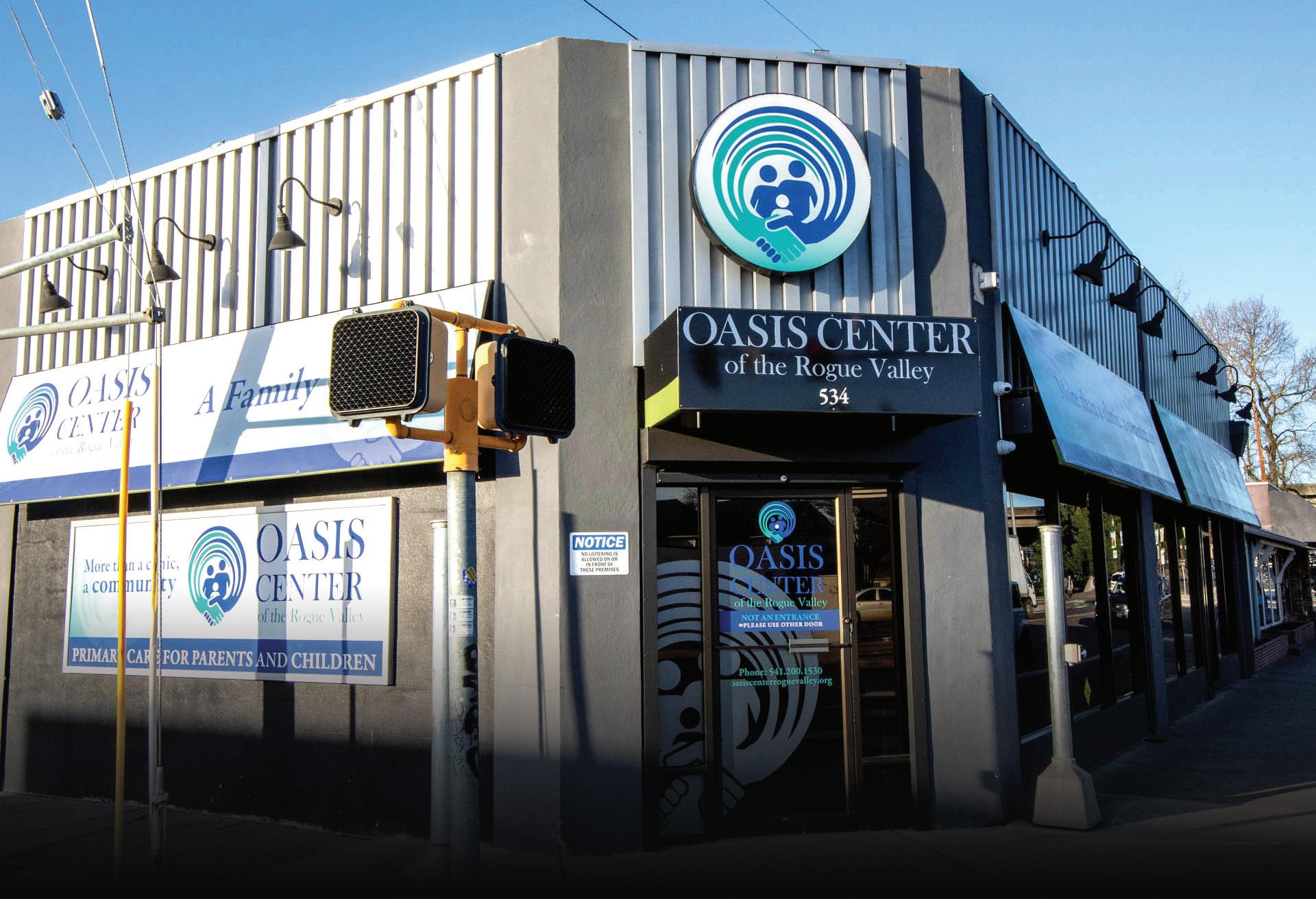
Oasis Center of the Rogue Valley
Southern Oregon clinic helps families break the chain of multi-generational addiction
STORY BY CAROLYN CAMPBELL
As Oregon’s drug decriminalization experiment comes to an end with the implementation of HB 4002, Dr. Kerri Hecox, founder and medical director of Oasis Center of the Rogue Valley, believes the new law, coupled with an infusion of funding, could help families struggling with generational addiction and trauma gain access to life-changing treatment.
Located in one of Medford’s poorest, crime-riddled neighborhoods, the nonprofit recovery center is one of a handful nationwide providing comprehensive, “wrap-around” care for “system-involved” families.
“Many people are not getting arrested for possession crimes,” Hecox said. “They’re getting arrested for a lot of property and theft crimes related to their substance abuse. If we were to intervene and get them into treatment, they could potentially break out of that lifestyle.”
According to a recent study by the Northwest Center for Family Support (NCFS), 2.2 million children are currently impacted by opioid use disorder. “Without policies and interventions that support effective prevention, treatment, and recovery, by 2030, 4.3 million children will be affected by opioid use in the U.S.”
Unlike treatment centers that focus on the individual, the Oasis model offers a family-centered, two-generation approach to disrupt the cycle of multigenerational poverty, addiction and trauma.
In 2019, after working for five years as a child abuse medical examiner for Jackson County, Hecox co-founded Oasis Clinic. In less than five years, Oasis has expanded into a sprawling center, called “the campus,” providing medical care, addiction treatment, temporary housing for people (particularly pregnant women) waiting for residential treatment, coordination of community resources, and its newest program, the Little Acorns toddler and preschool classroom.
The NCFS study acknowledged that while family-centered treatment and preventive interventions for parents with Substance Use Disorder (SUD) are met with enthusiasm, the policy, capacity and funding restraints have curtailed many attempts. While many centers struggle, Oasis has been able to continue to grow.
“We are fortunate to have strong, collaborative partnerships that enable us to provide extensive services for our (approximately) 1,000 patients, with a third of them pediatric,” Hecox said.
On a chilly spring morning, Hecox and executive director Kristen Johnson stood at the entry to the sprawling block-long center. Six feet from the door, a small commercial refrigerator stocked with bins of organic broccoli, potatoes, celery and carrots stood next to the reception desk.
Working in collaboration with the Family Nurturing Center Farm and Food Program, Oasis provides fresh organic produce to patients, daily meals for Little Acorns preschool, and therapeutic programs for families to grow, prepare and share healthy meals while strengthening parent-child relationships.
10 | The Other Oregon • Summer 2024
FEATURES
In less than five years, Oasis has expanded into a sprawling center, providing medical care, addiction treatment, temporary housing for people waiting for residential treatment and more.
Pulling a recipe from a folder taped to the door, Johnson added, “Healthy food is critical for addiction recovery as well as the physical and cognitive health of children, but for many of our patients, cooking with fresh vegetables can be intimidating. Recipes make it easier for them to try something new.”
Across the large entry, morning light flooded into a large babyblue room surrounded by a four-foot-high pony. Inside, a miniature basketball hoop, chalkboards, toddler-sized tables, overstuffed couches, and a six-foot bear drooped over a yellow play structure are arranged to provide developmentally appropriate play areas where children can explore and process.
“This is our Family Room,” Hecox said. “We designed an open floor plan so staff can supervise children while their parents privately discuss issues not appropriate for them to hear. Plus, it allows our providers to observe and tailor our services to their individual needs.”
In addition to providing child care, Oasis partners with Jackson County Early Intervention (EI) to host informal early intervention playgroups modeling age-appropriate exercises while fostering community building among families in recovery. Since the program’s inception, follow-up with Jackson County Early Intervention has increased nearly 50%.
With 30% of Oasis patients involved with child welfare, community justice, or both, this nonpunitive approach is a drastic change from Hecox’s previous positions in settings where social service and law enforcement agencies had little engagement in recovery work.
A cornerstone of the Oasis approach is their Multi-Disciplinary Team (MDT). Though based on the Family Court model, a justice system program that coordinates and addresses the various system requirements for families, the Oasis MDT is not mandatory or court-required.
“Oasis MDT develops a unified plan meeting the various requirements of the different agencies — a probation officer, a child welfare worker, a self-sufficiency specialist and their SUD treatment team — and most importantly, I think, creates a sense that all of these agencies are working as a team to support the patient to create a better life for themselves and their children,” Hecox said.
Kim, a 45-year-old mother of four, is part of the MDT program. For almost three decades, her addictions led to homelessness, destructive relationships, exchanging sex for drugs, dealing and stealing. Five years ago, credit card fraud landed Kim in prison, pregnant with her youngest son. Upon release, she became an Oasis patient.
Choking back, tears Kim confided, “This is the first place I’ve felt like I mattered, where providers aren’t punching a time clock and collecting a check.”
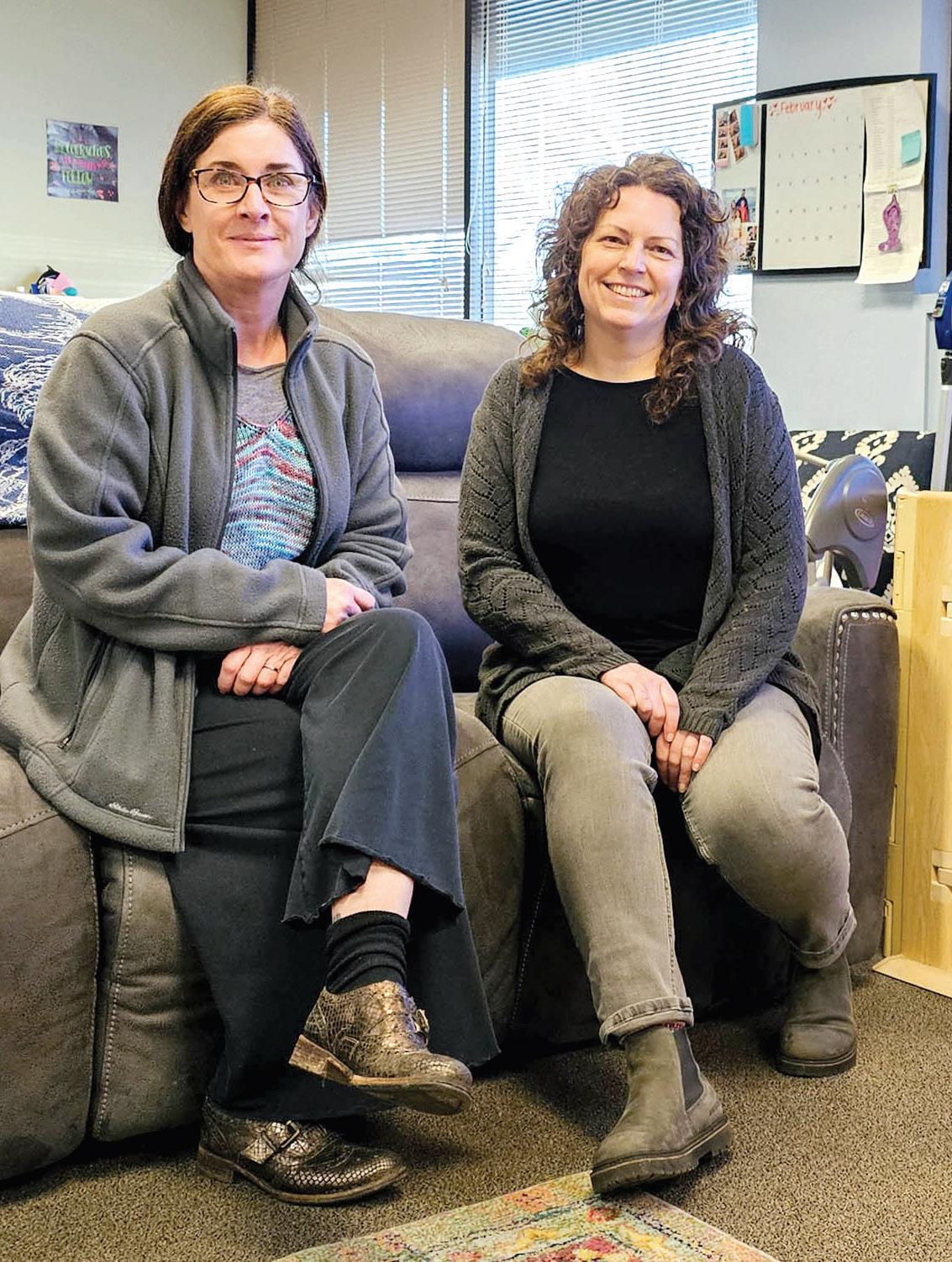

A VOICE FOR RURAL OREGON TheOtherOregon.com The Other Oregon • Summer 2024 | 11 FOR RURAL
»
Dr. Kerri Hecox (left) with Kristen Johnson in Family Room of Oasis Center. PHOTO BY CAROLYN CAMPBELL
Kristen Johnson demonstrates sensory toys in Little Acorns classroom, a play-based social-emotional learning environment of the Oasis Center. PHOTO BY CAROLYN CAMPBELL

Dr. Karen Scott, the president of the Foundation for Opioid Response Efforts (FORE), affirmed Kim’s experience, describing how women like Kim frequently choose abusive and predatory relationships over being shamed or judged for being an addict.
Recently, Kim’s addiction cycle started spiraling out of control.
“I wasn’t in a good place,” Kim said. “Me and my kids were living in a hotel. We were about to get evicted because of our (13) cats. Dr. Hecox was so great! She came and got the cats, adopted the kittens, and got the adults fixed. At my next appointment, she told me, either you make the call, or I will.”
That “call” was to Child Welfare.
Hecox said there is a delicate balance between being firm yet compassionate and allowing people to have agency over their lives. When a patient’s drug use adversely affects their kids, Hecox will tell them, “Child Welfare needs to be contacted.”
For Kim, this agency has enabled her to take the first step to gaining control over her life.
“I now have a team to help me! I’ve never had a team of people behind me before,” she said.
Scott commended Oasis’s approach.
“Most programs aren’t equipped to deliver such comprehensive care. When recovery centers allow patients to engage agencies early on, it reduces the chances of social services reflexively deciding to separate the family,” Scott said.
For Hecox, working closely with law enforcement is integral to the mission of Oasis.
“The more we communicate and support them in a better understanding of how addiction and trauma affect the brain, it helps law enforcement lead with compassion, which in turn helps the person make better choices,” she said.
Jackson County Sheriff Nate Sickler said partnerships with centers such as Oasis are key to creating a safe, livable county.
“If people were to make assumptions about, hey, here’s this conservative sheriff, and a doctor who wants to save lives, they might not consider that our common ground is the best way to address an issue threatening families across our community,” he said. “I don’t think anybody has any idea what’s coming in the next few years. If we are to break this cycle, mental health providers, substance use disorder experts and law enforcement have to work together.”
When Hecox was asked what she hopes will occur with the implementation of HB 4002, she replied, “If we want to change the trajectory of these families, we need to bring together as many resources as we can and be ready to support them when they are ready to change. It’s the only way we can break the cycle and provide a different life for the next generation.”
Carolyn Campbell is a freelance writer.
12 | The Other Oregon • Summer 2024
Little Acorns classroom at Oasis Center of the Rogue Valley.
PHOTO BY CAROLYN CAMPBELL
2024 Scholarship Winners!

JOSIE TAYLOR
Crane Union H.S. to Treasure Valey C.C.
$2,500

GUS HENDRICKS
Klamath Union H.S. to Hamline University
$2,500
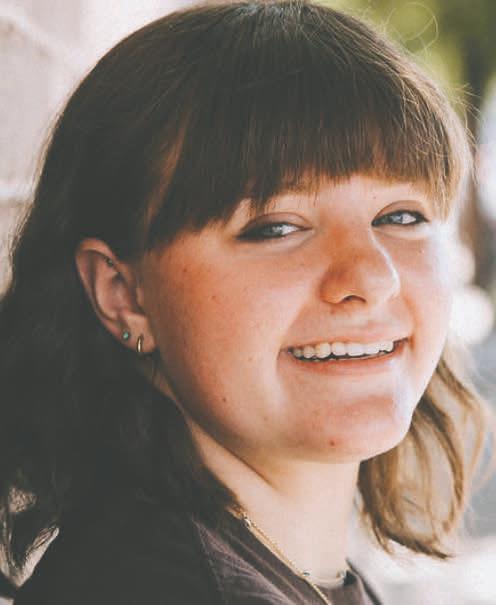
ANDRAYA MCNARY
Crook County H.S. to Central Oregon C.C.
$2,500


ROBERTO RODRIGUEZ PEREZ
The Dalles H.S.
$2,500

ELIZABETH ARCEO DORADO
The Dalles H.S. to Columbia Gorge C.C.
$500

BLAKE HERINCKX
North Lake School to Oregon State University
$2,500

VIOLET WOODS
Sherman County H.S. to Univ. of Hawaii - Mānoa
$500
The 2nd Annual NewSun Energy Climate + Ag Scholarship Essay Contest challenged high school seniors in Harney, Crook, Lake, Gilliam, Wasco, Sherman, and Klamath counties to write about how climate change is affecting their communities and way of life. We’re honored to support and encourage these students as they pursue their dreams.

Congratulations to our
high-speed internet for all
STORY BY DANIEL BROOKS, SAMANTHA O’CONNER AND BENNETT HALL
Making connections with fiberoptic broadband internet access to every corner of Oregon

Ed Negus, a Vietnam veteran who lives in Prairie City, has a doctor’s appointment at the VA clinic in Burns, 70 miles away.
But instead of making the long drive down Highway 395 to see his health care provider, he just pops into the John Day Elks Lodge 13 miles up Highway 26, where a small office behind the bar is equipped with a smart TV and a laptop with a high-speed internet connection that allows him to talk to his doctor as if they were in the same room.
Negus is among the dozens of Grant County veterans who use the telehealth link, provided through a partnership between the Elks and the Department of Veterans Affairs, for routine health care appointments that used to require a three-hour round trip to the Burns clinic — or a seven-hour round trip to the VA hospital in Boise.
“This is great for us,” Negus said. “This helps out a bunch.”
What makes the program work is fast, reliable internet service — the kind of service that has only been available in this isolated Eastern Oregon community for a few years now and is still lacking in more remote corners of the state.
But that may not be true for too much longer. Fueled by a massive infusion of federal funding, Oregon is launching a major push to expand the infrastructure needed to make a broadband internet connection available to every household in the state.
It’s all part of an ambitious initiative dubbed Internet for All, a $65 billion undertaking with the aim of ensuring that, by the year 2030, every American has access to reliable high-speed internet service for work, education and health care.
“It’s the biggest investment in high-speed internet ever,” President Joe Biden said in a 2023 speech touting the program. “Because for today’s economy to work for everybody, internet access is just as important as electricity or water or other basic services.”
14 | The Other Oregon • Summer 2024 FEATURES
Giant spools of fiberoptic cable sit in a Rally Networks storage area in Mt. Vernon in June 2023. The company is engaged in several projects to extend high-speed internet access to remote parts of Eastern Oregon. NEIL NISPEROS PHOTO
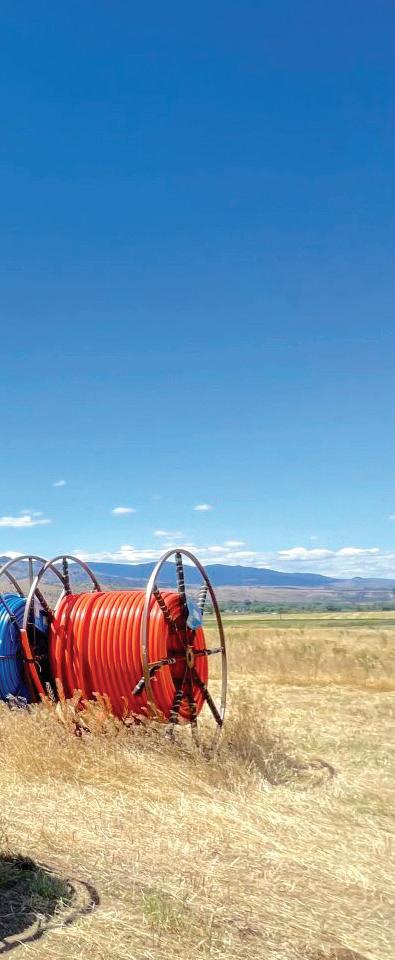
Fueled by a massive infusion of federal funding, Oregon is launching a major push to expand the infrastructure needed to make a broadband internet connection available to every household in the state.

Bridging the digital divide
The COVID-19 pandemic demonstrated the importance of being able to work, learn and hold meetings online — and the consequences for those who lacked the ability to do so, many of them living in remote, rural areas.
The federal government responded by pouring money into a nationwide effort to extend broadband capability to an estimated 8.5 million localities that commercial internet service providers had steered clear of because of the high cost of building infrastructure and the low density of potential customers.
As of late 2022, Oregon’s share of that federal largesse was $895.7 million, according to information on the Internet for All government website. The job of overseeing how that money is spent falls to the Oregon Broadband Office, housed in Business Oregon, the state’s economic development agency.
“That aspirational goal of internet for all is really the goal — that’s the expectation of Congress, that’s the expectation of the White House,” Business Oregon spokesperson Nathan Buehler said. “It’s got three priorities that kind of became big issues during COVID and that is work, education and health care.”
There are two primary programs set up to make that goal a reality, Buehler said.
“The first is the ARPA CPF (the American Rescue Plan’s Capital Projects Fund),” he said. “That program is administered by the Treasury in response to what we saw during COVID. So, that one is $10 billion nationally and Oregon is getting $157 million.
“The second federal program is called the BEAD program,” Buehler added. “It stands for Broadband Equity Access and Deployment. That one is $42.5 billion nationally. And Oregon’s award amount is $688.9 million.”
There are several other federal programs funneling money to the state for internet connectivity.
So far, for instance, Oregon has received about $25 million through the Tribal Broadband Connectivity Program, which aims to extend broadband on tribal lands. The state has also been awarded $24 million from the Enabling Middle Mile Broadband Infrastructure program, which connects local fiber optic networks to major trunk lines, and $782,000 through the Digital Equity Act, which funds digital literacy programs and other efforts to bring the benefits of the internet to underserved communities. »
A VOICE FOR RURAL OREGON TheOtherOregon.com The Other Oregon • Summer 2024 | 15
Ed Negus uses a high-speed internet link provided through a partnership between the John Day Elks Lodge and the Department of Veterans Affairs to meet remotely with his VA doctor in John Day. BENNETT HALL PHOTO
Some of these programs are already up and running in the state, with the most recent addition being the ARPA Capital Projects Fund.
Others, most notably the Broadband Equity, Access and Deployment Program, are still being set up. Activities such as a challenge process and a subgrantee selection process will start this year.
“For the BEAD program, there are a number of hurdles that we have to get over before we can even get access to those funds,” Buehler said, but he added that the program is still on track to deliver results.
“We will run a grant program that pushes money out the door on a reimbursable basis to the eligible recipients,” he said. “It doesn’t come to Oregon as an earmark. As a matter of fact, states and U.S. territories are required to effectively apply for these funds.”
Grant applicants will have to have some skin in the game as well. Subgrantees, for instance, will have to provide at least 25% of a project’s cost in matching funds.
With that in mind, the Oregon Broadband Office’s analysis shows that BEAD funds will likely be sufficient to fund fiber-tothe-premises to the majority of unserved and underserved locations in the state. The office’s data suggests there is a business case, with between 75% and 90% of unserved and underserved locations, for applicants to request funding for fiber at a level that will be equal to the funds available.
That said, Buehler added, Business Oregon will have to account for how every dime of BEAD money is spent.
“And this will be effectively a line-by-line accounting for how we’re going to spend all $688.9 million and how we’re going to get somewhere in the neighborhood of 140,000 to 150,000 locations in Oregon connected,” he said.
Laying cable
But while the BEAD program is still getting off the ground, numerous efforts to extend high-speed internet to underserved parts of the state are well underway.
For instance, in 2022, Rally Networks (formerly Oregon Telephone Corp.) was awarded a $20.5 million package of loans and grants by the U.S Department of Agriculture’s ReConnect program. The company is in the process of laying fiber optic cable that will provide broadband internet access to 1,163 people, 41 businesses, 70 farms and four educational facilities in Baker, Grant and Malheur counties.
A separate $6 million grant, awarded in 2020, funded a partnership between Rally and the Grant County Digital Network Coalition to bring broadband to the Grant County towns of Seneca, Canyon City, Long Creek and Monument and the Wheeler County community of Spray. That project was expected to connect 418 households, 22 businesses, 22 farms, three schools and two fire stations, according to information provided by Sen. Ron Wyden’s office.
Markus Bott, vice president of operations with Rally Networks, said the company currently has several different projects going on in Oregon, including several that are waiting on environmental clearance before they can proceed.
“The Forest Service, the BLM and the State Historic Preservation Office, all those agencies kind of weigh in on routes and things like that in those projects,” Bott said.
In Eastern Oregon, he estimated Rally has placed around 200

McCracken, one of the founding board members of
miles of fiber in the last year, connecting toward the Boise area.
“As part of our ReConnect, we’ve put in about 50 miles out of 90 total in the Long Creek and Seneca areas,” Bott said.
Altogether, Bott said, the projects will help bring high-speed internet to around 2,000 previously unserved residents in Eastern Oregon.
Tribal projects
Other federal grant programs specifically target the digital divide in Indian Country.
In 2022, for instance, the Tribal Broadband Connectivity Program awarded a $15.5 million grant to the Confederated Tribes of the Umatilla Indian Reservation, Wyden’s office said. The money was expected to bring broadband fiber to 342 unserved households on the reservation in Umatilla and Union counties.
The need for broadband services varies depending on where you are on the reservation, said Bruce Zimmerman, economic and development tax administrator for the tribes. Some areas have decent service while others have poor, intermittent or no service.
“One of the goals is to provide service throughout the reservation,” Zimmerman said. “In other words, we want all the households eventually to be able to interconnect into good, highspeed, reliable internet broadband services.”
Having that connection, he said, will help tribal members in a variety of ways, from telemedicine to distance learning to operating small businesses from their homes.
Last month, the U.S. Department of Agriculture awarded the tribes a separate grant for technical assistance. The $250,000, Zimmerman said, will provide the tribes with technical assistance to help manage their expanding broadband network.
“For example, what I refer to as a cost recovery system,” he said. “So when we build our rate structure — in other words how much the customer pays, the households pay — we understand how much of that rate has to include a reserve or a portion within that rate to make sure that there’s sufficient funding for the current operation and maintenance functions as well as there’s money set »
16 | The Other Oregon • Summer 2024
Didgette
Grant County CyberMill, sits in the nonprofit’s first location in Seneca. The Seneca CyberMill offers public access to high-speed internet service for area residents. BENNETT HALL PHOTO




Meet our full team and learn about our services at www.pwlobby.com
aside for capital reinvestment into the system. So, as time goes on, as assets need repair or become outdated, they can be replaced so that the (network) will continue to provide reliable service.”
Independent efforts
In some rural areas of the state, nonprofits have taken a different approach to providing high-speed connectivity to those who need it.
One example is the Grant County CyberMill, a public benefit nonprofit funded through government grants and private donations. In the last three years, the organization has set up fully furnished internet cafes in Seneca and Prairie City.
Each location has several computers, WiFi, a conference room with videoconferencing capabilities and work spaces for students,
Embracing the power
And then there are organizations like the Elks and their partnership with the Department of Veterans Affairs to provide telehealth services for veterans like Ed Negus.
“In the past year, we’ve done 60 veterans that did not have to go to Burns or Boise,” said Bob Van Voorhis, who helps manage the telehealth program for the John Day Elks Lodge and also serves as a volunteer bus driver for the free transportation program that takes vets to out-of-town doctor’s appointments.
“But that’s just part of what we do here as far as high-speed internet,” added Van Voorhis, a Vietnam vet who retired to Grant County after a long civilian career in the computer industry.
Once a month, he said, the lodge uses its broadband connection
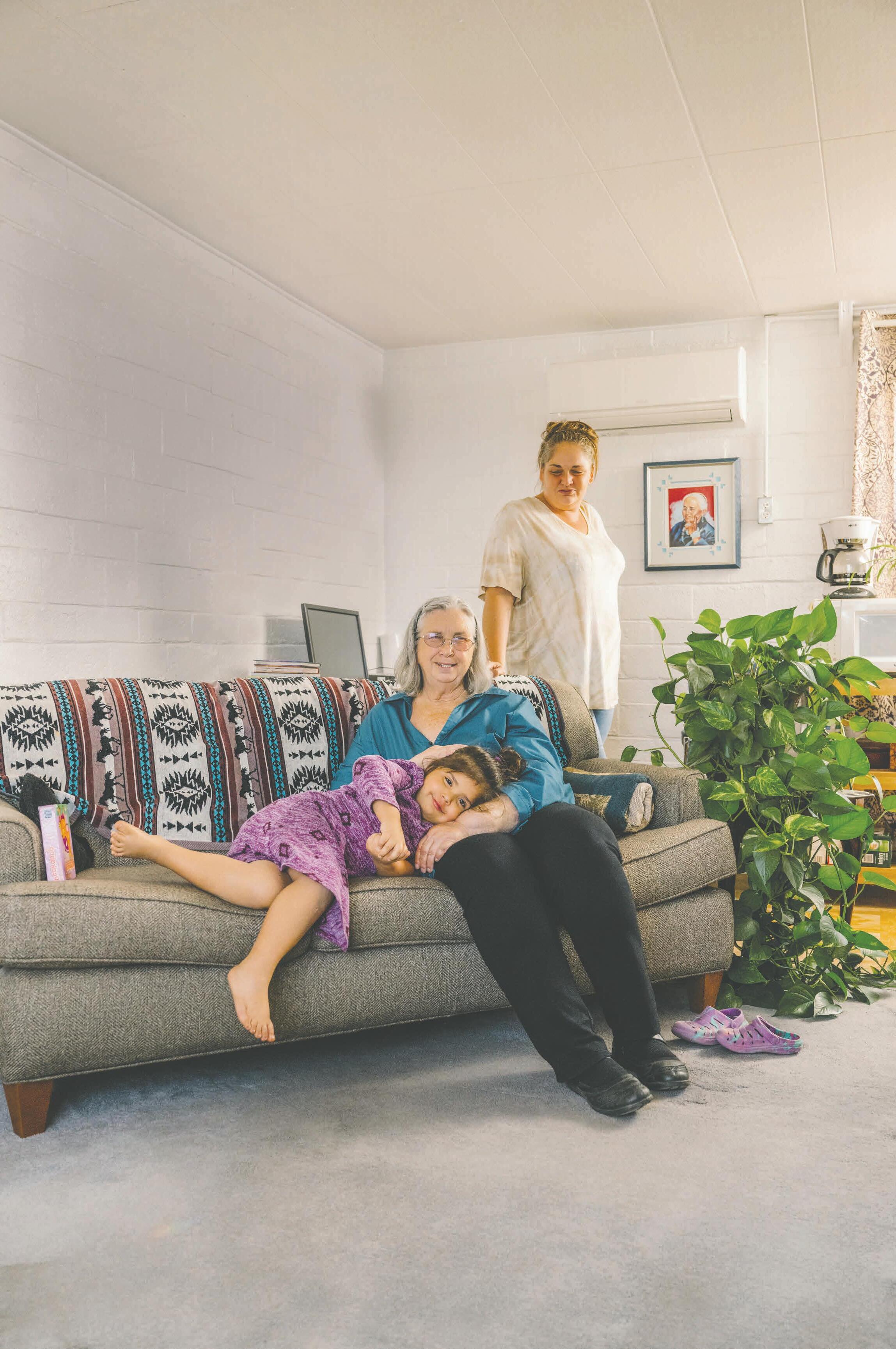 Exec. Director, Turtle Cove
Exec. Director, Turtle Cove
Offering energy savings and solutions that power your life. Find cash incentives and resources at energytrust.org powers you? what
Created a comfortable home and haven for her community, and families in need.
Wanda
Leading the Charge for Sustainability in the Mid-Columbia Region





Supporting Over 350,000 Acres Boosting the Economy Innovative Solutions Our Work In Action
3D printed concrete home building
Layer Line 3D lays solid foundation for the
future
 STORY BY BY ALIYA HALL
STORY BY BY ALIYA HALL
W
ithin the next 60 days, Malheur County will have the first Oregon house built using a new, non-traditional construction method: 3D printed concrete.
“We are basically helping to write the book on how 3D concrete home building is done in the state of Oregon, while also contributing to the industry as a whole,” Shawn McKay, chief executive officer of Layer Line 3D, said. “As more people become aware of the technology we are only seeing an increase in demand.”
Layer Line 3D in Ontario is one of about 50 homebuilders in the U.S. working to establish the new industry, McKay said. Layer Line 3D currently has more projects planned in Malheur County, as well as in John Day, Burns, and western Oregon and Idaho.
3D concrete printing is the process of pumping concrete and placing it with a large scale printer — Layer Line 3D uses a 35-feet by 50-feet printer. This printer operates on an x,y,z coordinate system and deposits layers of concrete in approximately 1-inch thick layers. The process is repeated until the object or structure being printed reaches its desired height, McKay said.
Originally, McKay said he got into 3D printing when he owned a construction company and machine shop, using small-scale 3D printers to prototype parts. In 2021, when John Day solicited bids for a 3D printed housing project, McKay was already doing work with the City.
“When the opportunity came up to bid on the job we were a natural fit,” he said.
Layer Line 3D’s mission is to address the growing housing crisis in the United States, with a focus specifically in rural communities within the Pacific Northwest.
“It is well known that there is a severe housing shortage in our state and across the country,” McKay said. “The idea is to create housing for work-force, transitional for elderly and starter homes for new families or first-time home buyers.”
Along with addressing the challenge of affordable housing, McKay said 3D concrete printing also provides support for an aging construction worker population and government mandates to increase housing productivity. »
20 | The Other Oregon • Summer 2024
MAKING A LIVING

Layer Line 3D’s mission is to address the growing housing crisis in the United States, with a focus specifically in rural communities within the Pacific Northwest. 3D concrete printing also helps address the challenge of affordable housing.

 Photos show 3D wall printing in progress. Layer Line 3D is an Ontario-based business that uses 3D concrete printing as a method to address rural Oregon’s affordable housing crisis. PHOTOS COURTESY OF LAYER LINE 3D
Photos show 3D wall printing in progress. Layer Line 3D is an Ontario-based business that uses 3D concrete printing as a method to address rural Oregon’s affordable housing crisis. PHOTOS COURTESY OF LAYER LINE 3D
The Other Oregon • Summer 2024 | 21 A VOICE FOR RURAL OREGON TheOtherOregon.com
“We need to use all of the tools in the toolbox to meet the challenges ahead of us,” he said.
Layer Line 3D offers a cost-attainable housing product that sells for “around the low $300,000s and below,” McKay said, with a range of floor plans from one to three bedrooms at sizes of 800 to 1,400 square feet.
When it comes to comparing traditional construction methods to 3D concrete printing, McKay said that there are “a lot of possible outcomes” in terms of cost and time, but their goals are to “produce homes faster and more affordably than traditionally constructed homes.”
Although McKay said there are challenges as an emergent technology in an established industry, they have spent “thousands of man hours to refine the large scale 3D printing process to what it is now.”
The biggest challenge of 3D concrete printing is inherent with any new technology, McKay said.
“There are no established protocols and so there is a lot of trial and error and figuring out not just what is the right-now solution, but what are the most cost-effective long-term solutions,” he said.
McKay added that most people are unfamiliar with 3D concrete printing in general, but the more people become aware of it and its benefits, he said, “the more we will see it as a regular part of the construction industry.”
Going forward, McKay’s goal is to see Layer Line 3D become an established home builder in Oregon, with multiple printers operating across the state.

“Providing any kind of housing is very rewarding in itself,” he said. “We are happy to be doing our part to bring an innovative solution to the housing crisis.”
Hall is a freelance writer from Portland.

DON’ T LET THE HEAT
SLOW YOU DOWN – INVEST IN
THE FUTURE OF YOUR
BUSINESS TODAY!
Energy Trust of Oregon offers cash incentives when you upgrade your aging equipment to energy-saving models. From efficient ductless heat pumps to top-of-the-line insulation, energy-efficient equipment will keep your business cool and comfortable, even on the hottest days. Upgrade today to start saving energy and money. Learn more at www.energytrust.org/existingbuildings

22 | The Other Oregon • Summer 2024
Aliya
Layer Line 3D’s design of their 3D concrete printed house project in Malheur County. IMAGE COURTESY OF SEDER ARCHITECTURE+URBAN DESIGN







EOU.EDU DISCOVER THE EASTERN EDGE AT EASTERN OREGON UNIVERSITY!
THE LAND state timber harvests
Clearcutting in the woods east of Astoria draws concern for neighbors
STORY BY OLIVIA PALMER

When Darren Orange received a letter from a surveying company in late March, he never expected it might lead to a clearcut next to his backyard.
Like many people living next to state forestland, Orange knew there was always a possibility the stands near his home east of Astoria might be managed or thinned — but last month, he watched as crews marked the trees along his property line with fluorescent orange spray paint and neon pink flags. A section of forest behind that line, he learned, had been slated for a timber harvest.
“Most of us bought homes here with the idea that being a forest that this would be here as long as we were here,” Orange, a painter, said. “We’re realizing now due to the state’s revenue concerns that that’s not always the case.”
The site near Orange’s property, known as Mothball Hill, is one of several clearcut timber operations proposed in the Oregon Department of Forestry’s Astoria District Office annual operations plan. The plan itself is nothing out of the ordinary — as the name suggests, the district publishes one every year. This year’s response from the public, however, is.
In the final days leading up to the plan’s public comment deadline last week, two proposed harvests have drawn the attention of neighbors, and about half a dozen people spoke out at a recent Clatsop County Board of Commissioners meeting.
“Typically, the only feedback we get during that public outreach process is usually from the environmental stakeholders and the industrial stakeholders,” Astoria District Forester Dan Goody said. “We very rarely get local folks chiming in.”
The Mothball Hill operation would allow for a clearcut harvest on 99 acres across two units east of Astoria, bordering Orange’s and a handful of other property owners’ backyards. According to a preoperations report, the harvest would bring in an estimated $1.2 million. The Davis Ridge operation, on the other hand, proposes a 168-acre clearcut on two units in Brownsmead with an estimated $2.2 million net value.
While the public reactions to the proposed operations elevate local environmental concerns, they also point to a larger conversation about how the state manages its forests and what recent regulatory changes could mean for the future of timber harvests. They also beg the question of what residents can reasonably expect if they choose to live next to state forestland.
An annual process
Beginning in the late 1930s, Forest Trust Land counties, including Clatsop County, gave land that had been overharvested and abandoned by the timber industry to the state for timber management. »
A large tree on Darren
is
by the Oregon
of Forestry. PHOTO BY SHANNA MADISON
Orange’s property
marked
Department
24




At Umatilla Electric, we’re shaped by the people we serve. As a community-owned utility, we are driven to be more than a business, we are an energy partner. Learn more about how UEC is helping to power communities at: Hermiston Headquarters 750 W. Elm Ave. Hermiston, OR 97838 PH: (541) 567-6414 Boardman Operations Center 400 N.E. Eldrige Drive Boardman, OR 97818 Power THE OF COMMUNITY WWW.UMATILLAELECTRIC.COM
ME
SCAN
Now, one-third of the revenue from state timber sales goes back to the Department of Forestry, while the other two-thirds goes to local governments in counties that originally donated the land. Annual operations plans help local districts outline where those timber sales will be each fiscal year.
The agency’s work is guided under the umbrella of greatest permanent value, a principle that seeks to balance social, environmental and economic benefits. From there, they look to the state’s forest management plan, the district’s implementation plan and local harvest volume objectives for more specific guidance.
Goody said decision-making is a long process, with planning and surveys often beginning up to two years in advance. Determining where to harvest is essentially a process of elimination.
“We look at the whole forest in a GIS computer screen, say, ‘Here are all our habitat conservation areas,’ and you preclude those from the clearcut harvest. Here are all our stream buffers, or all our geotechnical areas in places that might have landslides,” he said. “You start taking all that stuff away, and then you see what you have left for potential harvests. And you line that up with our harvest objective, which is roughly 50 million board feet a year, and that pretty much dictates where we harvest.”
But this year, there’s also another consideration at play: the state’s habitat conservation plan.
Over the past few years, Goody said the Department of Forestry has found itself in a transition zone, following both the current forest management plan and strategies under the draft habitat conservation plan. The habitat conservation plan, which the Oregon Board of Forestry narrowly advanced in March, designates habitat conservation areas for threatened and endangered species across roughly 640,000 acres of state forests, primarily in Clatsop and Tillamook counties.
While the plan offers the Department of Forestry greater protections against Endangered Species Act-related lawsuits, it also means fewer portions of state forestland are available for timber harvest. In Clatsop County, Goody said around 40% of state forestlands fall into habitat conservation areas. Harvesting in those areas is limited to cuts that would actively improve habitat.
“That took a lot of choices off the table,” he said.
The district is now looking more intentionally at where to harvest in the remaining 60% — and if Mothball Hill and Davis Ridge are any indication, that can include areas near people’s homes.
The Astoria district office first began implementing elements of the draft habitat conservation plan strategies during the 2023 fiscal year. Following the transition, Goody said the district’s harvest objectives have dropped from 73 million board feet to around 50 million board feet per year. With the reduction in volume comes a reduction in value.
Based on modeling for the habitat conservation plan, Clatsop County has estimated it could lose up to 35% of timber revenue because of the decline in timber harvests, or more than $8 million annually.
“The counties are our primary financial stakeholder in our management, and so with a reduction in harvest is a reduction in money that goes to the county and local taxing districts,” Goody said. “So where we can, we are focusing on higher-return timber sales to minimize that financial impact to the counties.”
‘This is the wrong place’
For any given harvest, the Department of Forestry has to follow certain rules, like performing surveys and maintaining stream and slope buffers. When it comes to checking those boxes, Goody said this year’s proposed operations are pretty typical. The main difference is their proximity to people’s homes.
To concerned neighbors, that’s no small distinction.
“This isn’t something that I’m totally against, like most reasonable people,” said Trask Bergerson, of Bergerson Tile & Stone, whose property abuts Mothball Hill. “I just didn’t really expect it in my backyard.”
Proximity isn’t the only concern, though. Residents have also voiced apprehension about landslide risks, potential chemical sprays and impacts of clearcutting on nearby fish-bearing streams.
The northwest corner of the Mothball Hill site rests between the mouth of Clatsop County’s John Day River and the Columbia River, and portions of the Davis Ridge operation border Gnat Creek. Both bodies of water provide habitat for threatened and endangered fish. Although pre-operations reports for the sites indicate the Department of Forestry intends to establish stream buffers, that doesn’t necessarily assuage neighbors’ worries.
Orange said he keeps an organic garden and fruit trees on his property, and his wife owns an apiary business. Bergerson and his wife also keep an organic garden, and have recently been looking into digging a well on their property. Contaminated water or pesticides wouldn’t bode well for any of those operations.
“This is the wrong place,” Orange said. “It’s way too close to neighborhoods, it’s way too close to national protected areas, it’s in a watershed — a salmon-bearing watershed. It’s the wrong place.”
Denise Moore, a Brownsmead resident and licensed massage therapist whose property abuts part of the proposed Davis Ridge operation, feels similarly. On a recent Friday morning, she walked along her property line with a handful of neighbors, stopping at a massive tree just past the southern edge of her 3 acres, near a stream that eventually trickles into Gnat Creek.
Moore isn’t sure what might become of the stand near the stream if a clearcut was approved, but she worries older trees like this one might not be spared. According to pre-operations reports, certain trees at the proposed Davis Ridge site are estimated to be up to 83 years old, and a few acres at Mothball Hill contain trees as old as 103.
“We need to protect what little bit of this is here,” she said. “There’s plenty of other places that they can harvest that don’t impact a valuable waterway.”
But according to Goody, that’s part of the problem: there aren’t plenty of places to harvest — or at least, not as many as there used to be. While a stand of 80-year-old trees is closer to maturity than a stand of 20-year-old trees, it also grows much more slowly and provides more timber volume per acre. Part of adapting to revenue needs is being thoughtful about those trade-offs.
“Those are the balances we’re making all the time when we’re thinking about these things,” Goody said.
This spring, residents met with North Coast Communities for Watershed Protection, a Rockaway Beach-based environmental group that has formed an Astoria chapter, to discuss next steps. One idea that has emerged is to conduct independent surveys as a baseline to compare with the Department of Forestry’s preoperation reports.
Olivia Palmer is a reporter at The Astorian in Astoria.
26 | The Other Oregon • Summer 2024
Lakeview Alger Theatre
Oregon Rural Teacher Corps
Lakeview Alger Theatre
By: Chaney Coman, for The Roundhouse Foundation
By The Roundhouse Foundation
By: Chaney Coman, for The Roundhouse Foundation
The Alger Theatre in Lakeview is one of Oregon’s latest entries to the National Parks Service Registry of Historic Places. Now owned and operated by Lakeview Community Partnership, a nonprofit dedicated to the economic revitalization of downtown Lakeview, the Alger has served as a cultural and entertainment center for the community since it opened in 1940.
The Oregon Rural Teacher Corps (ORTC) is making significant strides in addressing the critical shortage of educators in rural districts across the state. Established as a collaboration between Eastern Oregon University (EOU) and the Oregon Community Foundation (OCF), this innovative program aims to recruit, train, and support teachers committed to serving in rural areas.
The Alger Theatre in Lakeview is one of Oregon’s latest entries to the National Parks Service Registry of Historic Places. Now owned and operated by Lakeview Community Partnership, a nonprofit dedicated to the economic revitalization of downtown Lakeview, the Alger has served as a cultural and entertainment center for the community since it opened in 1940.
Moreover, the ORTC is committed to promoting diversity and equity within rural schools. By recruiting teachers from diverse backgrounds and providing training in culturally responsive teaching practices, the program seeks to create inclusive learning environments where all students feel valued and supported.
“It is unusual for a small community such as ours to receive this honor,” shared Ginger Casto, a volunteer for Lakeview Community Partnership (LCP) who has been dedicated to the revitalization of the Alger since the organization purchased the building in 2018.
The ORTC recognizes the unique challenges faced by rural communities, including limited access to educational resources, small student populations, and geographic isolation. To combat these obstacles, the program provides comprehensive support to aspiring teachers, including scholarships, mentorship opportunities, and specialized training in rural education.
“It is unusual for a small community such as ours to receive this honor,” shared Ginger Casto, a volunteer for Lakeview Community Partnership (LCP) who has been dedicated to the revitalization of the Alger since the organization purchased the building in 2018.
Since its inception, the ORTC has seen promising results, with a growing number of educators choosing to pursue careers in rural schools. By addressing the shortage of teachers in these under-served areas, the program not only improves educational outcomes for students but also strengthens rural communities as a whole.
LCP has worked with a historic preservation consultant to renovate the Theatre since 2019. Though the pandemic and rising costs slowed initial fundraising and renovation efforts, the LCP membership has worked diligently to refurbish the historic marquee sign board and purchase the adjacent building, called the “Annex,” which will be remodeled to accommodate future needs for performance, ADA restrooms, offices and storage.
LCP has worked with a historic preservation consultant to renovate the Theatre since 2019. Though the pandemic and rising costs slowed initial fundraising and renovation efforts, the LCP membership has worked diligently to refurbish the historic marquee sign board and purchase the adjacent building, called the “Annex,” which will be remodeled to accommodate future needs for performance, ADA restrooms, offices and storage.
One of the key features of the ORTC is its emphasis on community engagement and cultural competency. Participants in the program are encouraged to immerse themselves in the local community, fostering strong relationships with students, families, and community members. By understanding the specific needs and values of rural communities, ORTC teachers can better tailor their approach to education and make a lasting impact on students' lives.
Roundhouse Foundation is proud to support the Oregon Rural Teachers Corps student cohort.
“Lakeview is located 55 miles from the nearest theater in Alturas, CA and 100 miles from Klamath Falls. There is no other facility that can accommodate both film and cultural events,” said Casto.
“Lakeview is located 55 miles from the nearest theater in Alturas, CA and 100 miles from Klamath Falls. There is no other facility that can accommodate both film and cultural events,” said Casto.
The Alger has remained operational throughout the restoration, offering eclectic programming, including film screenings (everything from Tombstone to touring independent short films), comedy shows, and a rentable space for local community events, like annual dance recitals and school concerts.
The Alger has remained operational throughout the restoration, offering eclectic programming, including film screenings (everything from Tombstone to touring independent short films), comedy shows, and a rentable space for local community events, like annual dance recitals and school concerts.
In 2023, LCP completed Phase 1 of their Alger renovation in part with support from Roundhouse Foundation. Phase 1 included facade repairs, exterior painting and many small upgrades to electrical. The iconic ‘Alger’ neon sign was repaired and returned in December, lit up for the first time in its new form just in time for the holidays. Future work includes additional exterior work, before tackling interior upgrades.
In 2023, LCP completed Phase 1 of their Alger renovation in part with support from Roundhouse Foundation. Phase 1 included facade repairs, exterior painting and many small upgrades to electrical. The iconic ‘Alger’ neon sign was repaired and returned in December, lit up for the first time in its new form just in time for the holidays. Future work includes additional exterior work, before tackling interior upgrades.

Learn more about the Alger Theatre on their Facebook page facebook.com/AlgerTheaterLakeview/
Learn more about the Alger Theatre on their Facebook page facebook.com/AlgerTheaterLakeview/
The second class of the Oregon Rural Teacher Corps at the Eastern Oregon University campus in La Grande. Pictured left to right are in front; Scott Wardwell, Karina Diaz Lara, Nicole Ryan, Daniel Puerta, Janea Young, and Logan Nedrow. In back, BoDean Tayer, Killian Sump, Garrett Beckman, Micah Grogan, Kaleb Rainsberry, and Ollie Baker. Not pictured is Lonnie Slapinski


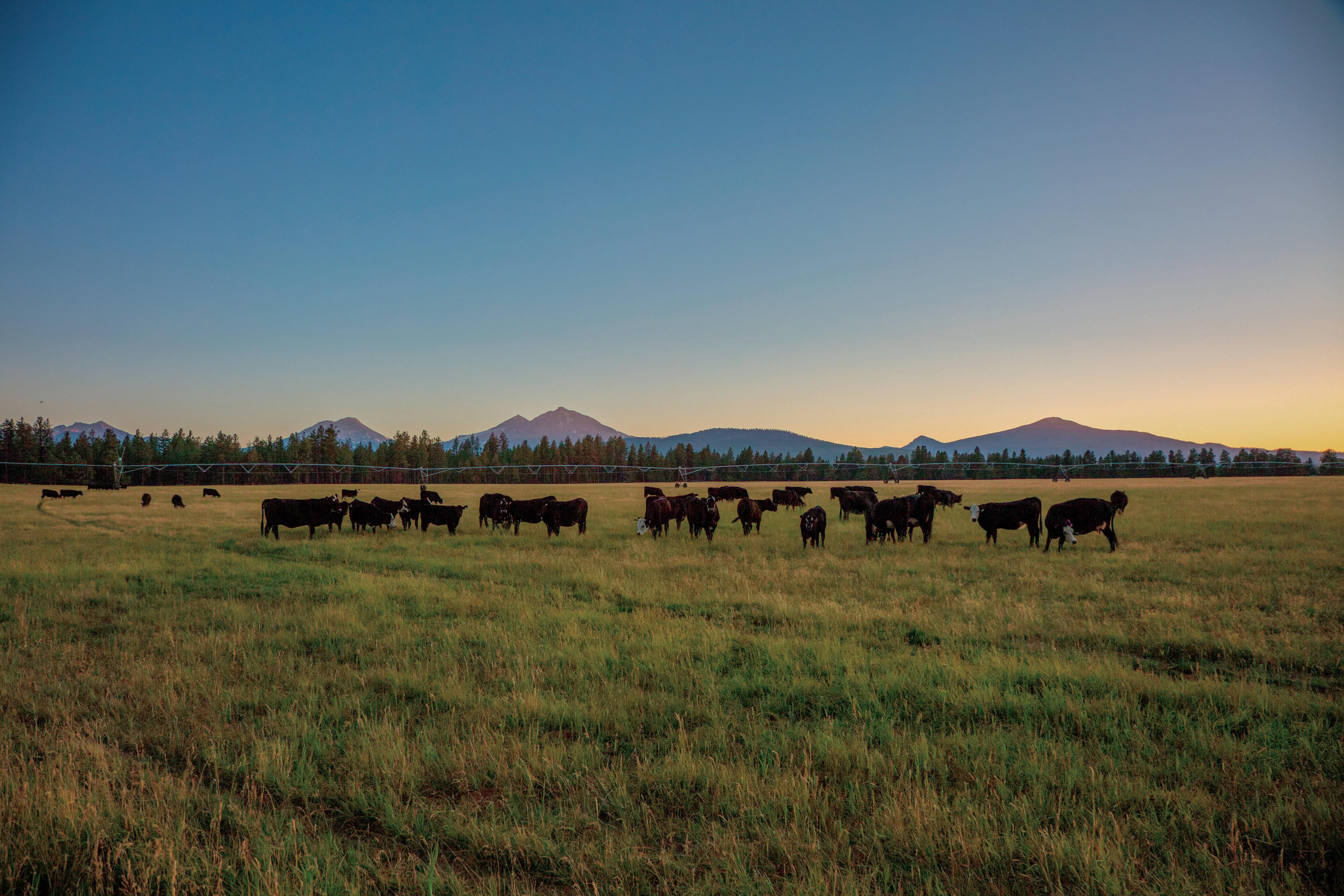
today
Listen today on your favorite streaming platform
Listen today on your favorite streaming platform
A podcast about how philanthropy can better serve rural communities to spark
A podcast about how philanthropy can better serve rural communities to spark systemic change
FundingRural.com
Cattle
image by The Photo Treehouse
systemic change
FundingRural.com
image by The Photo Treehouse
Cattle
podcast about how philanthropy can better serve rural communities to spark systemic change
A
FundingRural.com
Listen
on your favorite streaming platform
self
-
sustaining food supply
‘Urban Rural Action’ teams help bridge divides in southern Oregon
STORY BY KEVIN OPSAHL

roduce intake was alive and well one Tuesday in May at Rogue Food Unites in Ashland.
Fresh organic produce was delivered in boxes on large pallets to the facility on Walker Avenue. The produce, ranging from ruby red tomatoes to large heads of iceberg lettuce, came from the Rogue Valley-based Fry Family Farm.
Once the produce was loaded into the facility, scores of volunteers as well as Jesus Rios, client liaison manager for Rogue Food Unites, helped prepare it for the “Neighbors Unites Farmers Markets” that the nonprofit provides throughout the valley.
Rios and the volunteers did it all with smiles on their faces.
Rogue Food Unites — which started in 2020 as a way to supply food to victims impacted by the South Obenchain and Almeda fires — has long provided food to anyone in need, particularly in times of crisis.
In addition, they are working on a new months-long project to give food to one underserved rural community, with the goal that the project can eventually be self-sustaining.
The project is one of several occurring in four Oregon counties under a civic participation program called “Uniting for Action on the Economy in Southern Oregon,” meant to to address ongoing problems, ranging from food security to employment. Each county — Jackson, Josephine, Douglas and Klamath — chooses a community partner to help carry out the project, from February to November 2024.
“It seemed like a really great opportunity to develop some skills and work with people from different backgrounds,” Rios said. “I am excited about it.”
“Uniting for Action” falls under the nonprofit Urban Rural Action, which assigns the teams in Oregon, Maryland, Pennsylvania, Wisconsin and Arizona, to “(b)ring Americans
28 | The Other Oregon • Summer 2024
P
THE CULTURE

together across divides to tackle our nation’s most urgent challenges,” according to the organization’s website.
In Oregon, two co-directors and four coordinators oversee a team of 20 “uniters,” to carry out various projects.
Jenny Seward, a co-director of Oregon’s “Uniting for Action,” said the UR Action teams’ work is critically important at a time when the U.S. is seen as increasingly polarized.
“In order for our country to really be as strong, democratic, and as vibrant as we could be, it’s really important that we learn to listen to each other — even if we don’t agree,” Seward said.

Marla Estes, the Jackson County UR Action coordinator, pointed to studies which have shown that giving people with diverse viewpoints a project to work on together helps them bridge their differences.
“Depolarization starts within, and we have to understand ourselves and make some choices about how to be in the world,” Estes said. “But we can’t if we don’t understand what we’re working with in ourselves.”
Before team members begin projects, they meet together to learn how to bridge their differences through “the ABCs of constructive dialogue.” They then create “problem tree” as a way to analyze their project topic. That analysis is used to create a project plan.
“The process of learning how to work together is at least, if not more, important than the project,” Estes said.
Fola Kareem, 34, who immigrated to the U.S. from Nigeria, is a UR Action team member in Klamath County. He believes many Americans think in “silos” and he hopes bring a communal way of working to the team.
“What I tend to bring is that sense of community; the sense of diversity, as well,” Kareem said. “We hope to bring diverse perspectives to the way things are being done.”
Rios said food is not only a big part of the economy, but it’s a part of people’s well-being.
“Food is so important for the nourishment of our bodies, our brains, our cognitive development,” Rios said. “So, it’s a very positive project. I want to be a part of something that’s going to have a positive impact on people.”
In Douglas County, team members are focused on the issue of employment by helping 16-26 year-olds obtain their driver’s license. The community partner is Phoenix Charter School of Roseburg.
In Josephine County, team members are creating a “toolkit and action plan” to bring rural communities in the Applegate region together, Seward said. The community partner is A Greater Applegate.
In Klamath County, team members are creating a youth-advisory council to help young people find civic engagement opportunities. The community partner is Klamath County Economic Development Association.
Kevin Opsahl is a reporter at Rogue Valley Times in Medford.
A VOICE FOR RURAL OREGON TheOtherOregon.com
Stephanie Peterson, a volunteer at Rogue Food Unites, processes produce in Ashland.
JAMIE LUSCH PHOTO
Produce is processed at Rogue Food Unites in Ashland. JAMIE LUSCH PHOTO

Focused on agriculture. More importantly, focused on you. With over a century financing agriculture, we know firsthand the challenges and rewards you face every day. Let’s work together to help you build your best future. Learn more at AgWestFC.com. This institution is an equal opportunity provider and employer.



According to the 2022 State of Mental Health Report1, Oregon youth have the highest prevalence of both mental illness and substance use disorder in the United States. About 1 out of 17 Oregon youth have a diagnosed substance use disorder, and Oregon has experienced the largest increase of youth substance use disorder in the country.
But there’s hope. Coalition for a Healthy Oregon plans are ensuring mental and behavioral health services are available and accessible for all children in Oregon. As an example, the 2022 CCO Metrics Report shows our CCOs are ensuring kids entering the foster care system are receiving timely and comprehensive assessments.







Children should be seen and heard www.cohoplans.org 1Reinert, M., Fritze, D. & Nguyen, T. (October 2021). “The State of Mental Health in America 2022”, Mental Health America, Alexandria VA. (https://mhanational.org)
Oregon Farm Bureau is the state’s most inclusive agriculture organization, representing about 6,300 family farmers and ranchers who raise everything from cattle to hazelnuts. First established in 1919, Farm Bureau is a grassroots, nonprofit organization representing the interests of family farmers and ranchers in the public and policymaking arenas. We aim to keep agriculture thriving for future generations, expand its economic opportunity and viability, and educate society about why ag is important.
Our policy and political priorities develop from a democratic process, beginning at the county level. Positions, ideas, and initiatives then make their way to the OFB annual convention, where Farm Bureau members from around the state meet to discuss and vote upon the organization’s goals for the coming year.

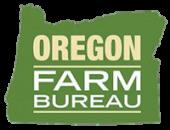
Visit OregonFB.org to learn more or call us at 503.399.1701 So, What is Farm Bureau? So, What is Farm Bureau?
Make your voice heard Join Oregon Farm Bureau Today More than 96% of Oregon Farms and ranches are family-owned and operated. Nearly 1 out of every 8 jobs in Oregon relies on agriculture
























 STORY BY KYLE ODEGARD
STORY BY KYLE ODEGARD






















 Exec. Director, Turtle Cove
Exec. Director, Turtle Cove





 STORY BY BY ALIYA HALL
STORY BY BY ALIYA HALL


 Photos show 3D wall printing in progress. Layer Line 3D is an Ontario-based business that uses 3D concrete printing as a method to address rural Oregon’s affordable housing crisis. PHOTOS COURTESY OF LAYER LINE 3D
Photos show 3D wall printing in progress. Layer Line 3D is an Ontario-based business that uses 3D concrete printing as a method to address rural Oregon’s affordable housing crisis. PHOTOS COURTESY OF LAYER LINE 3D

































